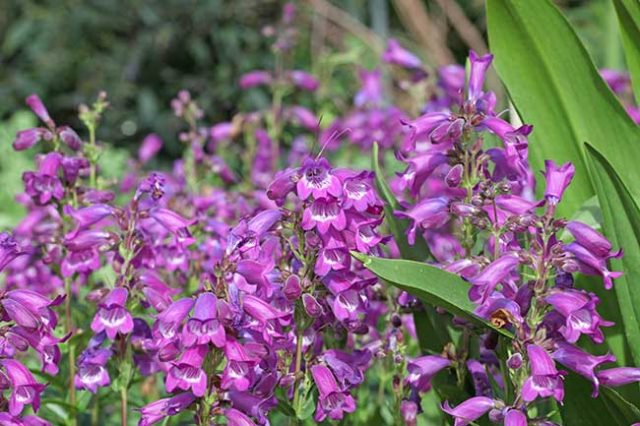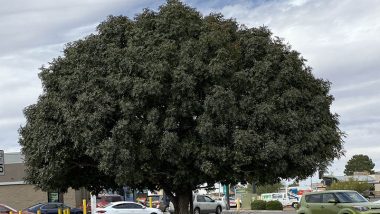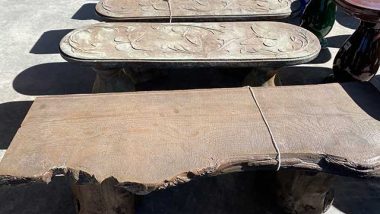Last updated on November 22nd, 2025 at 06:00 am
Popular types and varieties
How to Care for Penstemon Varieties. There are about 270 species of plants from the genus Penstemon in the world. They all differ in the color scheme of flowers and leaves, as well as the height of the bush, the number of shoots, and the green mass. The flowering period and lifespan of the plant depend on the variety.

The most popular types of plants are penstemon whitish, alpine, bearded, red-leaved, foxglove and many others.
The foxglove species tolerate frost well and is distinguished by pale pink flowers, sometimes completely white. The bushes are quite tall, reaching 1 meter.
“Hartwegii” is one of the most popular varieties; it has flowers of different colors on one bush. The inflorescences are large in size. In this case, the core is always white. The height reaches 50-60 cm, and the shrub blooms almost until the first autumn frosts.
“Husker Red” is another frost-resistant variety. It is distinguished by red leaves (almost bronze), and shoots reach 90 cm in height. The flowers, on the contrary, are very delicate, with a pink tint.
Flowering begins relatively late, in late June – early July.
Penstemon bearded is a hybrid species with large flowers. The arrows reach a height of up to 90 cm. It is distinguished by early abundant flowering. Flowers on one bush can be of different shades.
Penstemon pine-haired is a low-growing evergreen representative of this species. Its bright red, orange flowers can completely cover the bush. The leaves are needle-shaped, and the shoots are quite thin and flexible. The duration of abundant flowering is about 2 months.

Landing
The plant is quite unpretentious but prefers illuminated areas. With enough sunlight, flowers and leaves become more saturated in color. While a plant planted in the shade (without access to sunlight), although it will be able to develop, the color of the flowers and leaves will be several tones paler. It is better to choose a place without drafts but with constant access to fresh air.
When planting a plant on a site, it is important to choose the right soil. The soil should be light and loose. It is recommended to use organic fertilizers (humus) for feeding. Fertilization should be done in the spring before penstemon begins to bloom.
Penstemon is easy to germinate from seed. The culture is characterized by rapid growth and will begin to bloom in the first summer after planting the seeds. Sowing seed material for seedlings is recommended in early March.
The seeds are slightly deeper into the moist soil; there is no need to sprinkle the seeds with soil. The temperature for rapid germination is needed at least +25°C. Covering the boxes with film and periodically opening them for ventilation is recommended. The first shoots should appear in the second week after sowing.
After the formation of 3-4 full-fledged leaves, the sprouts are replanted. An excellent option for temporary replanting would be peat pots, which are subsequently placed directly into open ground. About 30 cm should be left between bushes.
The perennial crop does not like frequent transplants and may become diseased, which will negatively affect further growth and flowering.
Care during cultivation
How to Care for Penstemon Varieties. Penstemon is an unpretentious crop, but still requires some attention. With proper care, the plant will delight the gardener with abundant blooms of bright, bell-shaped flowers. The plant requires regular watering and loosening of the soil. It is necessary to monitor the condition of the soil around the crop, remove weeds, and periodically mulch the soil using crushed sawdust or compost, Pine bark mulch is another excellent option for mulching. Fine gravel should be placed in the holes to improve drainage when planting.
In open ground in one place, penstemon can grow well and bloom for up to 4 years (some varieties up to 7 years). After this, the bushes age and lose their decorative appearance. Periodically, it is better to remove old plants and plant new ones in their place. This can be done using pre-prepared seedlings or cuttings.

Watering
The crop requires regular watering, provided the soil has good drainage. Avoid stagnant moisture under the bush. Otherwise, the plant may die. Between waterings, the soil should dry out a little on top (about 3-5 cm deep), but not dry out too much. The bushes can be sprayed periodically.
Top dressing
Due to excessive feeding, the plant may begin to form new shoots abundantly, but without flowering. The bush will only grow a green mass. To avoid such a negative effect, it is recommended to fertilize in the spring before the plant begins to actively grow.
If the soil is not saturated enough, then fertilizing can be repeated 1-2 more times during the summer. To do this, you should use natural organic fertilizers or fertilizers with a high phosphorus content.
Phosphorus fertilizers are recommended to increase the flowering period. In the summer, you can mulch the soil 1-2 times using compost, peat or crushed sawdust.
Organic bone meal fertilizer is frequently used as a soil amendment and is widely regarded as an effective plant nutrient. Typically incorporated during planting, it is believed to facilitate strong root establishment post-transplantation, enhancing overall root growth.
Trimming Penstemon
Gardeners recommend removing faded buds and cutting off shoots after flowering has ended. This is done to speed up the start of abundant flowering again. The plant will not waste energy and nutrients to maintain shoots without forming ovaries. It is recommended to thin out large mature bushes by removing the oldest shoots; this will give a more decorative appearance to the plant.
Preparing for winter
In autumn, the bushes are completely cut off and covered with spruce paws. In winter, it is better to cover the area around the rhizome warmer to avoid soil freezing and minimize damage to the root system. In dry soil, penstemon can withstand frosts down to -10°C.
Reproduction
The fastest and most commonly used method of propagating penstemon is to divide a large bush into 3-4 parts. This procedure is carried out in the spring before the period of active growth. The rhizome of a large plant is divided into several equal parts or a small part is separated and planted in a prepared place. After transplanting, for the first few days, it is necessary to ensure good watering, the soil should remain moist.
Bushes that are 3 years old or older are suitable for division. Younger shrubs will die when divided. The division also helps to rejuvenate an old plant; this must be done after 4-5 years of the life of the bush. Otherwise, it stops blooming, grows taller, and loses its attractive appearance.
Another common propagation method is the cutting method. In spring, when pruning, the required number of young healthy shoots is cut off. They are buried 2-3 cm in a mixture of compost and peat (or moss), removing the lower leaves. Some gardeners recommend treating the cut sites with special products that accelerate the formation of the root system. In moist soil, cuttings quickly begin to take root. When the root system is fully formed (this takes about a month), the cuttings are ready for planting in open ground.
For creeping varieties, the method of propagation by offsets is used. Part of the young shoot is slightly deepened and sprinkled with soil. This place requires constant watering; the soil is not allowed to dry out completely. After about a week, the first roots will appear, and then the young plant is separated from the mother bush by cutting off the shoot. After some time, when the young plant gets stronger, it can be transplanted to another place.
How to Care for Penstemon Varieties
Penstemon Plants for Landscape Color.
The Author of this Post is by Robert Hood.

BIO; “I am Robert, a dedicated gardening enthusiast, and a certified horticulturist. My profound passion for plant care has led me to share my expertise and knowledge through this blog. With years of hands-on experience, I am committed to providing you with expert tips, practical advice, and valuable insights to help your plants thrive. Let’s embark on a journey together to create flourishing green spaces that bring joy and serenity to our lives.”


